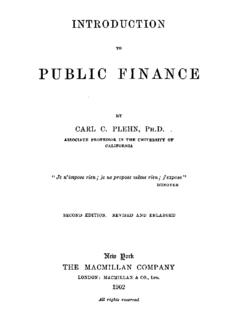Transcription of REGIONAL SALES TAX ANALYSIS UPDATE Chaddick …
1 REGIONAL SALES TAX ANALYSIS UPDATE . Chaddick institute for Metropolitan Development November 4, 2009. This UPDATE offers a summary of data on retail SALES for the 2nd quarter of 2009. It is made available as part of the REGIONAL SALES Tax ANALYSIS project, an initiative sponsored by the Chaddick institute for Metropolitan Development at DePaul University in cooperation with ERA AECOM. Launched in the spring of 2008, the project involves a review of longitudinal ANALYSIS of buying behavior from 1995 to the present to better understand the effects of changes in rates of retail- SALES taxation. The extent to which the rate of retail SALES taxation in Cook County exceeds the rates of taxation in the various Collar Counties in metropolitan Chicago remained largely unchanged between the 1st and 2nd quarter of 2009.
2 Cook County's SALES tax rates (based on simple averages of all incorporated communities) remain, on average, + percentage points higher than those in Lake County. The differentials are somewhat higher between Cook and DuPage ( ), McHenry ( ), Will ( ). and Kane ( ). These differences are much higher than they were in 1995 and 2000, giving consumer a greater incentive to alter their buying habits to reduce the tax burden. Average SALES Tax Differential Cook County vs. Collar Counties Source: REGIONAL SALES Tax ANALYSIS Project, 2009. Retail SALES in suburban Cook County (defined as the entire county excluding Chicago and Evanston). deteriorated relative to the Collar Counties (and the country as a whole) in the 2nd quarter of 2009, the most recent data period available. SALES in suburban Cook fell by , a rate exceeding all other county areas in metropolitan Chicago by a considerable margin.
3 The next-worse decline was recorded by Lake County, which faced a fall. This was the poorest quarterly performance for suburban Cook, both in absolute and relative terms, since the increase in the Cook County SALES tax rate took effect in July 2008. Decline in Retail SALES Suburban Cook vs. Collar Counties Decline in 2nd quarter 2009 vs same period previous year As noted on the table below, the cumulative decline in retail SALES during the six months of 2009. in suburban Cook was This decline is also significantly higher than that reported by any suburban area over this period. DuPage County, the second worst, faced a decline, followed by Lake County ( ). As reported in August, the gap between suburban Cook and the Collar Counties are larger than can be explained by long-term economic trends.
4 Cumulative Decline in Retail SALES January June, 2009 vs. Same Period Previous Year County Area Decline Suburban Cook DuPage Lake Kane McHenry Will There is continuing weakness in retail SALES in boundary communities near the edge of Cook County, which face high differentials in SALES tax with neighboring communities. The table below summarizes some of the SALES declines in boundary communities. We discuss this phenomenon extensively in an earlier report released last May. Change in Retail SALES Cook County Boundary Communities 2nd Quarter 2009. Community SALES Tax Rate Change Barrington Barrington Hills Elk Grove Village Hoffman Estates Orland Park Park Forest Schaumburg Tinley Park REGIONAL Average Suburban Cook Average Major suburban retail centers in suburban Cook County continue to underperform relative to smaller markets.
5 The following table shows the extent of the decline in retail SALES in the largest markets. Change in Retail SALES Largest Cook County Suburban Retail Centers 2nd Quarter 2009. Arlington Heights Des Plaines Elk Grove Village Glenview Hoffman Estates Matteson Mt. Prospect Niles -11,8%. Northbrook Oak Lawn Orland Park Palatine Schaumberg Skokie Tinley Park REGIONAL Average The City of Chicago has been performing marginally better than the region as a whole in recent quarters but worse than the national average. The relative strength of retail activity in the city appears to be primarily due to three factors. First, the quantity and price-competitiveness of retail inventory is rising, partially due to the addition of new big-box stores, reducing the extent of the retail losses to neighboring communities.
6 (In future weeks, we will work to develop new estimates using same-store data, which may paint a less favorable portrait of retail- SALES trends in the city.). Second, residents of the city tend to be more reliant on public transportation than those in more outlying areas, limiting their ability to travel to neighboring communities for a price savings. Finally, the city's economy is not as dependent on the housing industry (and housing starts) as the Collar Counties. ---- 2009 ----- 2008 1st Quarter 2nd Quarter City of Chicago Suburban Cook REGIONAL Averae - Contact Information Questions about this UPDATE should be directed to Joseph P. Schwieterman, , and Julia Anderson, who available by emailing or or calling 312/362-5732. More extensive data ANALYSIS made available earlier this year can be downloaded at





